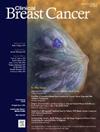Evaluating Surgical Outcomes Between Estrogen Receptor Positive Invasive Lobular and Invasive Ductal Carcinoma of the Breast—A Propensity Matched Analysis
IF 2.5
3区 医学
Q2 ONCOLOGY
引用次数: 0
Abstract
Introduction
Invasive lobular carcinoma (ILC) contributes significantly to the global cancer burden and is the most common of the histological “special types” of breast cancer. ILC has unique features setting it apart from the more common invasive ductal carcinoma (IDC). Despite differences, treatment algorithms do not consider histological differences.
Aim
To determine the differences in treatment and outcomes of ILC relative to IDC in a strict case-matched cohort study at a tertiary referral, specialist, breast cancer center.
Methods
All Estrogen receptor positive (ER+) ILCs from 1999 to 2015 were matched for; age, tumor size, grade, PR/HER2 status, nodal stage and metastases with ER+ IDCs from the same period. Surgical and systemic treatments were assessed along with overall (OS) and disease-free survival (DFS).
Results
762 cases in total were analyzed (1:1 matching; ILC:IDC). ILC cases were more often treated with mastectomy (37.5% vs. 28.6%, P .009) and those who received breast conserving surgery (BCS) more often had an incomplete resection (30.2% vs. 19.6%, P .01). IDC were more often treated with NACT (5.5% vs. 14.4%, P < .001). Mean DFS were similar between ILC and IDC; 148.3 vs. 141.4 months (P .112) but OS was significantly longer in the ILC group; 165.7 vs. 134 months (P .002). This trend was consistent among the subset of patients undergoing BCS. For ILC undergoing BCS, mean DFS was 129.8 vs. 128.3 months for IDC (P .418) and OS was 155.4 and 110.7 months respectively (P < .001). Incomplete resection at the time of index surgery did not alter the disease free or overall survival in either the ILC or IDC patients to a level that reached statistical significance.
Conclusion
In this cohort study, the strict matching of ILC and IDCs for a number of prognostic indicators, demonstrates the impact of lobular histology with a clarity not previously observed. ILCs have comparable survival outcomes to patients with IDC but at the expense of more extensive index and revisional surgery. There is a need for awareness of these facts among surgeons and patients for optimal treatment prioritization and provision.
评估雌激素受体阳性浸润性乳腺小叶癌和浸润性乳腺导管癌的手术效果--倾向匹配分析
浸润性小叶癌(ILC)在全球癌症负担中占很大比例,是乳腺癌组织学 "特殊类型 "中最常见的一种。浸润性小叶癌具有独特的特征,有别于更常见的浸润性导管癌(IDC)。尽管存在差异,但治疗算法并未考虑组织学差异。在一家三级转诊乳腺癌专科中心进行的严格病例匹配队列研究中,确定 ILC 与 IDC 在治疗和预后上的差异。将1999年至2015年期间所有雌激素受体阳性(ER+)的ILC与同期ER+的IDC在年龄、肿瘤大小、分级、PR/HER2状态、结节分期和转移等方面进行匹配。对手术和全身治疗以及总生存期(OS)和无病生存期(DFS)进行了评估。共分析了 762 例病例(1:1 匹配;ILC:IDC)。ILC病例更多采用乳房切除术(37.5% 对 28.6%,0.009),而接受保乳手术(BCS)的病例更多采用不完全切除术(30.2% 对 19.6%,0.01)。接受 NACT 治疗的 IDC 患者更多(5.5% 对 14.4%,< .001)。ILC和IDC的平均生存期相似;分别为148.3个月和141.4个月 ( .112),但ILC组的OS明显更长;分别为165.7个月和134个月 ( .002)。这一趋势在接受BCS治疗的患者中也是一致的。对于接受 BCS 的 ILC 患者,平均 DFS 为 129.8 个月,而 IDC 为 128.3 个月 ( .418) ,OS 分别为 155.4 个月和 110.7 个月 ( < .001)。指数手术时的不完全切除并没有改变ILC或IDC患者的无病生存期或总生存期,达到统计学意义上的水平。在这项队列研究中,ILC 和 IDC 在多项预后指标上的严格匹配,清楚地表明了小叶组织学的影响,这是以前从未观察到的。ILC患者的生存结果与IDC患者相当,但要付出更多的指数和翻修手术的代价。外科医生和患者有必要了解这些事实,以优化治疗的优先顺序和提供。
本文章由计算机程序翻译,如有差异,请以英文原文为准。
求助全文
约1分钟内获得全文
求助全文
来源期刊

Clinical breast cancer
医学-肿瘤学
CiteScore
5.40
自引率
3.20%
发文量
174
审稿时长
48 days
期刊介绍:
Clinical Breast Cancer is a peer-reviewed bimonthly journal that publishes original articles describing various aspects of clinical and translational research of breast cancer. Clinical Breast Cancer is devoted to articles on detection, diagnosis, prevention, and treatment of breast cancer. The main emphasis is on recent scientific developments in all areas related to breast cancer. Specific areas of interest include clinical research reports from various therapeutic modalities, cancer genetics, drug sensitivity and resistance, novel imaging, tumor genomics, biomarkers, and chemoprevention strategies.
 求助内容:
求助内容: 应助结果提醒方式:
应助结果提醒方式:


